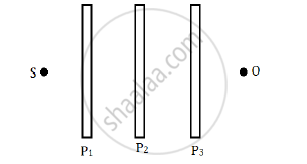Advertisements
Advertisements
Question
State and obtain Malus’ law.
Solution
When a beam of plane polarised light of intensity I0 is incident on an analyser, the light transmitted of intensity I from the analyser varies directly as the square of the cosine of the angle θ between the transmission axis of polarizer and analyser. This is known as Malus’ law.
I = I0 cos2θ
Proof:
- Let us consider the plane of polariser and analyser are inclined to each other at an angle θ.
- Let I0 be the intensity and ‘a’ be the amplitude of the electric vector transmitted by the polariser.
- The amplitude ‘a’ of the incident light has two rectangular components, (acos θ) and (a sin θ) which are the parallel and perpendicular components to the axis of transmission of the analyser.
- Only the component (a cosθ) will be transmitted by the analyser. The intensity of light transmitted from the analyser is proportional to the square of the component of the amplitude transmitted by the analyser.
- I ∝ (a cos θ)2 I = k(a cos θ)2
Where k is constant of proportionality.
Malus’s law
I = ka2 cos2 θ
I = I0 cos2 θ
Where, I0 = ka2 is the maximum intensity of light transmitted form the analyser.
Special cases:
Case (i):
When θ = 0°, cos 0 = 1, I = I0Case (ii):
When θ = 90°, cos 90° = 0, I = 0
APPEARS IN
RELATED QUESTIONS
With the help of neat diagram, explain how non-polar dielectric material is polarised in external electric field of increasing intensity. Define polarisation in dielectrics.
Draw a neat labelled diagram showing the plane of vibration and plane of polarisation for polarised light.
Three identical polaroid sheets P1, P2 and P3 are oriented so that the pass axis of P2 and P3 are inclined at angles of 60° and 90° respectively with the pass axis of P1. A monochromatic source S of unpolarised light of intensity I0 is kept in front of the polaroid sheet P1 as shown in the figure. Determine the intensities of light as observed by the observer at O, when polaroid P3 is rotated with respect to P2 at angles θ = 30° and 60°.

What dose a polaroid consist of?
Show, using a simple polaroid, that light waves are transverse in nature. Intensity of light coming out of a polaroid does not change irrespective of the orientation of the pass axis of the polaroid. Explain why.
Why does an unpolarised light incident on a polaroid get linearly polarised ?
Using the phenomenon of polarisation, show how the transverse nature of light can be demonstrated.
The refractive indices of glass and water w.r.t. air are 3/2 and 4/3 respectively. Determine the refractive index of glass w.r.t. water.
What is the Brewster angle for air to glass transition? (Refractive index of glass = 1.5)
Unpolarised light is passed through a polaroid P1. When this polarised beam passes through another polaroid P2 and if the pass axis of P2 makes angle θ with the pass axis of P1, then write the expression for the polarised beam passing through P2. Draw a plot showing the variation of intensity when θ varies from 0 to 2π.
The glass plate of refractive index 1.732 is to be used as a polarizer, its polarising angle is _______.
With the help of an experiment, state how will you identify whether a given beam of light is polarised or unpolarized?
Green light is incident at the polarising angle on a certain transparent medium. The angle of refraction is 30° . Find
(i) polarising angle, and
(ii) refractive index of the medium.
What is the difference between polarised light and unpolarised light?
State Brewster’s law.
Discuss about Nicol prism.
Which of the following phenomena is not common to sound and light waves?
Can reflection result in plane polarised light if the light is incident on the interface from the side with higher refractive index?
For the same objective, find the ratio of the least separation between two points to be distinguished by a microscope for light of 5000 Å and electrons accelerated through 100 V used as the illuminating substance.
